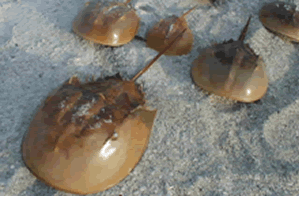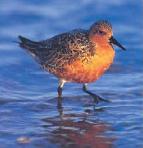Shedders
As I walk along the bay beach near my home, I am always looking for photo opportunities, particularly now with my new Panasonic Lumix DMC FZ30. One of the most remarkable encounters is the horseshoe crab shedders along the shoreline. One day last summer, I encountered literally hundreds of juvenile shedders. They were so fragile and so beautiful."What's a shedder?" you ask. As the horseshoe crab matures, and particularly while they are still juveniles, they molt their shells, as new ones grow.
 The shells themselves don't grow. The molted shells are usually very clean, having absolutely no rotting crab flesh in them. They are soft when wet, but dry to a fragile and papery little horseshoe crab model. I have one on my desk at work. It's one of dozens I picked up during one walk for a friend and co-worker to use as teaching tools on his job.
The shells themselves don't grow. The molted shells are usually very clean, having absolutely no rotting crab flesh in them. They are soft when wet, but dry to a fragile and papery little horseshoe crab model. I have one on my desk at work. It's one of dozens I picked up during one walk for a friend and co-worker to use as teaching tools on his job.Unfortunately, in spite of the hundreds that show up along my neighborhood's shoreline, these most ancient creatures need our protection. As they decline in numbers, so do their eggs.
 Per Citizens Campaign for the Environment,
Per Citizens Campaign for the Environment, Without a critical mass of horeshoe crabs and their eggs, migrating birds become too weak to complete their journey and successfully reporduce. Due to significant declines in horeseho crabs eggs, once common migrating shorebirds now face extinction. The dramatic population decline of the Red Knot and the Semipalmated Sandpiper are lined to the dramatic decline of shoreshe crab eggs.I urge everyone to visit Citizens Campaign, learn what you can, take action. Save "One of the oldest living species on Earth."
Why are horseshoe crabs disappearing?
The number of horseshoe crabs laying eggs on our beaches has declined significantly. The leading impact on horseshoe crab populations and shore bird viability is over harvesting of the horseshoe crabs. Horseshoe crabs are taken and chopped up for bait to catch eel and conch, which is sold in Asian markets in the Far East.
What is Being Done?
The Atlantic States Marine Fisheries Commission (Commission) regulates the taking of horseshoe crabs in state waters. Due to the dramatic decline of horseshoe crab eggs, the Commission is now considering adopting a two-year moratorium on horseshoe crab harvesting in the Delaware Bay. The Delaware Bay is the epicenter of horseshoe crab spawning. The Commission will be holding public meetings and soliciting comments from the public on the survival of the horseshoe crab. The ASMFC plans to vote in May on the draft Addendum IV of the interstate fishery’s management plan for Horseshoe Crabs. The Draft Addendum outlines a number of options to reduce or eliminate harvest of horseshoe crabs of Delaware Bay origin to encourage a rebound in the population.

















3 comment(s):
Hmm.... how's this for a slogan...
Save a Horseshoe Crab...Shred a Neocon!
By Anonymous, at
12:51 PM
Anonymous, at
12:51 PM
Or, just simply, "Shed a neocon!"
hehehehehe
By Dusty Dog, at
6:47 AM
Dusty Dog, at
6:47 AM
It's inspiring that people are working hard to protect these ancient creatures.
By Wandering Where is Waldo, at
12:55 PM
Wandering Where is Waldo, at
12:55 PM
Post a comment
<< Home